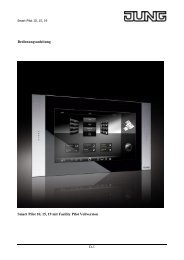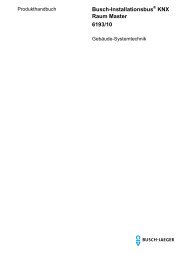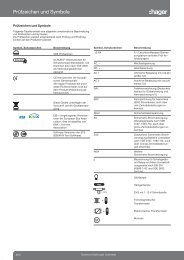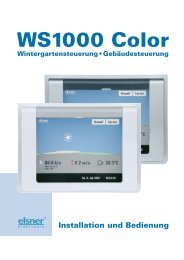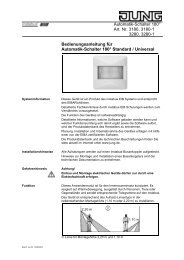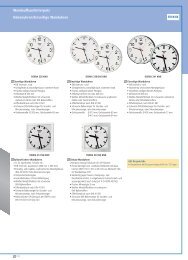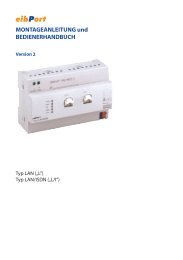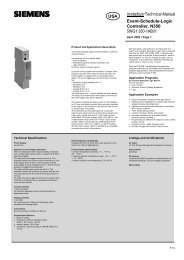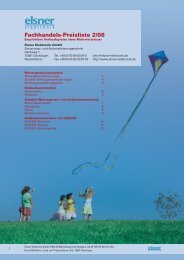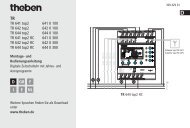Create successful ePaper yourself
Turn your PDF publications into a flip-book with our unique Google optimized e-Paper software.
4.2.4.10 Datalogger<br />
Introduction<br />
The datalogger offers the option of recording KNX/EIB data - for example temperature values,<br />
command values, lighting status, etc. - in various formats in the device memory and to show<br />
them in a value-time diagram on the display. In so doing, the data telegrams received from the<br />
KNX/EIB are 'compressed' at set intervals and saved in a datalogger channel of the panel as<br />
minimum, maximum and average values and can be displayed as necessary.<br />
The datalogger is primarily subdivided into the function modules "Datalogger recording" and<br />
"Datalogger display".<br />
4.2.4.10.1 Datalogger recording<br />
The KNX/EIB data are saved to a datalogger channel. A maximum of 20 datalogger channels<br />
can be inserted in the device project planning of the panel. New channels can be added by<br />
clicking the right mousebutton in the "Datalogger" parameter node in the plug-in. Each channel<br />
can be given a designation, so that it is easier to distinguish between the individual channels<br />
during later project planning work.<br />
Communication object and data format:<br />
Each datalogger channel possesses a communication object. The data format of this object can<br />
be specified using the "Data type" parameter in the parameter group of a channel. The following<br />
data formats are available...<br />
DPT 9,001 ... 9,021 (2 byte value), DPT 5,001 ... 5,004 (1 byte value),<br />
DPT 14,000 ... 14,079 (4 byte float value),<br />
DPT 8,001 (2 byte numeric value with plus/minus symbol), DPT 7,001 (2 byte numeric value),<br />
DPT 13,001 (4 byte numeric value with plus/minus symbol), DPT 12,001 (4 byte numeric value),<br />
DPT 6,010 (1 byte numeric value with plus/minus icon), 5,010 (1 byte numeric value).<br />
Recording period:<br />
Telegrams reaching the communication object are divided up within a recording period to various<br />
time intervals and assigned to them. At the end of each time period, the telegrams received<br />
are evaluated and a minimum and maximum interval value determined. In addition, an average<br />
value is calculated and saved.<br />
The smallest and largest values are evaluated as the minimum and maximum values. To calculate<br />
the average, the recorded values are totalled and divided by the number of recorded values.<br />
If, within a time period, only one telegram data value was received, then the minimum<br />
value = maximum value = average value.<br />
The recording period specifies the visible time window of the value-time diagram (scaling of the<br />
X axis) in the on-screen display (see chapter 4.2.4.10.2. Datalogger display).<br />
Using the parameter of the same name, the recording period can be configured separately in<br />
the datalogger channel in the ETS plug-in. The following recording periods can be configured<br />
with the appropriate time periods...<br />
- "Hour (60 intervals of 1 minute)":<br />
The recording period is set to one hour. Within this hour, 60 time intervals are formed, each<br />
1 minute in length, meaning that the incoming telegrams are evaluated 60 times and the<br />
results saved.<br />
- "Day (24 intervals of 1 hour)":<br />
The recording period is set to one day. Within this day, 24 time intervals are formed, each<br />
1 hour in length, meaning that the incoming telegrams are evaluated 24 times and the results<br />
saved.<br />
Order-No. 7574 00 1X<br />
Software "...590101"<br />
Functional description<br />
Page 99 of 222




